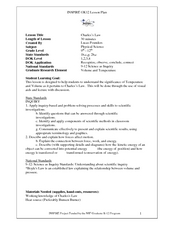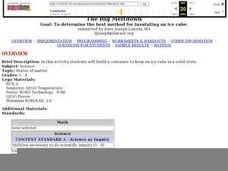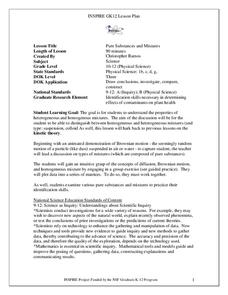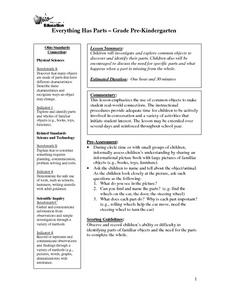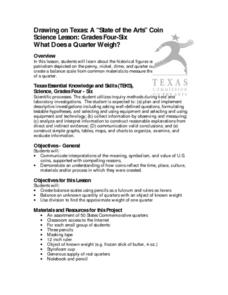Curated OER
Design your own Water Temperature Experiment
Students use Robolab sensors and software to design an experiment that incorporates the use of temperature probes. They conduct the experiment, complete a lab sheet, evaluate the results and then consider if their hypothesis requires...
Curated OER
Charles’s Law
Students describe the relationship between temperature and volume. In this chemistry lesson, students perform an experiment and record their their results. They use Charles' law to explain their observations.
Curated OER
Eat Your Sprouts Part I
Students will conduct a lab on the oxidation of an apple. The students will learn that the oxidation process can be halted when lemon juice is applied to the flesh of an apple because the lemon juice contains vitamin C, an antioxidant....
Curated OER
Numerical Determination of Drag Coefficients
Young scholars create a video of an object falling with a drag. For this physics lesson, students calculate drag coefficient using data from Logger Pro. They calculate velocity and acceleration of the object.
Curated OER
An Introduction to Thermal Spray Technology
Students discuss difference between kinetic and thermal energy, develop and demonstrate understanding of key concepts and characteristics underlying thermal spray techniques, list items used in their daily lives that are coated, examine...
Curated OER
Converting Metric Units and Prefixes
Students investigate the length of various objects. In this measurement lesson, students convert one metric unit to another. They explain the importance of a uniform system of measurement.
Curated OER
Capturing the Wind
Students collect and analyze data about wind speed. They build a Lego wind sail and measure the wind speed with a rotation sensor. They use software to analyze the data.
Curated OER
Measuring Water Temperature
Learners measure the temperature of three water sources. They collect data points every second for twenty five seconds for each sample using Lego Robolab temperature sensors, complete a worksheet, and analyze the data.
Curated OER
The Big Meltdown
Students work together to develop a container to keep an ice cube in a solid state. They identify the three stages of matter and test different materials for this experiment. They share their results with the class.
Curated OER
Molar Ratio
Students conduct an experiment in which they react sodium bicarbonate with hydrochloric acid to determine the molar ration between the two reactants. Students must write correct formula and a balanced chemical equation and explain how...
Curated OER
The Right Tool for the Job: Diagnosis Spectrum
Students watch a section of a medical TV show and individually make a written recommendation of appropriate imaging techniques to be used and explain why they chose these techniques. They participate in a discussion revealing their...
Curated OER
Pure Substances and Mixtures
Learners compare and contrast the properties of substances and mixtures. In this chemistry lesson, students simulate spontaneous mixing by performing a short class activity. They differentiate heterogeneous and homogeneous mixtures.
Curated OER
Ice Core Research
Students study the work of Dr. Hajo Eicken through an audio conference. They engage in a conference call with Dr. Eicken to identify how ice core research is designed and conducted. After asking Dr. Eicken questions, they record their...
Curated OER
Testing Foods
Students perform an experiment using brown paper bags to determine which foods have oil in them. This task assesses student's abilities to make simple observations and inferences from them.
Curated OER
Electrical Circuits And Switches
Learners design and draw circuits with batteries, small light bulbs and common household conductors. They build and test the circuit then modify it so someone who couldn't use their hands could turn the circuit on and off.
Curated OER
BEWARE OF POISONS
Students research and explore all the safety conditions to being exposed to poisons in real-world situations. They review/discuss/investigate about types, sources, effects and responses of poisons by creating general questions to pose to...
Curated OER
Sea Ice Research
Students study sea ice and its importance in climate and climate change. They discuss sea ice as a presence of a food source for marine animals in the arctic and complete a lab activity. After completing the lab, they watch a video...
Curated OER
A Living Watershed
Students, through this series of lessons, use local resources, speakers, print and video materials, as well as standard text materials to study the ecosystem of the local watershed.
Curated OER
Raquel's Radishes
Sixth graders develop a reasonable hypothesis for a fictional science fair investigation. 'Raquel' is going to grow radishes and test for the best way to nourish them. They create a bar graph and write conclusions.
Curated OER
Everything Has Parts
Young scholars investigate and explore common objects to discover and identify their parts. They also are encouraged to discuss the need for specific parts and what happens when a part is missing from the whole.
Curated OER
Different Types of Orange Juice Contain the Same Amounts of Vitamin C?
Students measure and compare the amount of vitamin C in orange juice samples. They discover the effects of different factors on the concentration of vitamin C. They participate in an experiment to test the orange juice.
Curated OER
Building A Sturdy Car
Pupils build a sturdy Lego car using a motor and a pulley. They determine how sturdy the car is by dropping it from the height of the teacher's knee.
Curated OER
Quarter Coin Cookies
Students study the historical figures and symbols of U.S.
patriotism depicted on the penny, nickel, dime, and quarter coins. They explore the processes involved in making coins, and how metals canchange in consistency from the...
Curated OER
What Does a Quarter Weigh?
Students study the historical figures and symbols of U.S.
patriotism depicted on the penny, nickel, dime, and quarter coins. They
create a balance scale from common materials to measure the approximate weight
of a quarter.

